2025 Genesis GV80 vs. 2025 Acura MDX: A Battle of Refreshed Luxury SUVs
The Lexus RX and TX are not only The Car Guide’s Best Buys in the midsize luxury SUV segment for 2025, but they also lead Canadian sales by a long shot, benefitting from the strong reputation for quality and reliability that Toyota’s premium brand has built over the years.
In recent weeks, we've had the opportunity to test drive two of their competitors, both of which have received a mid-cycle update for 2025—the Acura MDX and Genesis GV80. The former has lost ground over the years yet is still fairly popular, while the latter is not as successful (similar to American rivals from Cadillac and Lincoln) but might actually represent the closest thing to a German product.
- Also: 2025 Genesis GV80: Details That Make a Difference
- Also: 2025 Genesis GV80 and GV80 Coupe Land in North America
We've decided to compare them here to help you choose between the two and also identify their strengths and weaknesses in relation to the competition.
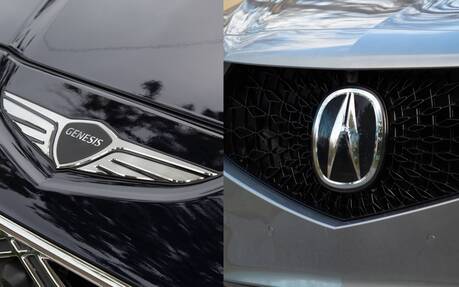
Design
Each of these midsize luxury SUVs boasts distinctive styling, maybe a little more so in the case of the GV80. Granted, the revisions Genesis has made for 2025 are fairly subtle, but the redesigned grille is quite striking, the dual-line headlamps make for a unique lighting signature, the bodysides are tastefully complemented by the addition of chrome trim and new wheels measuring 20 or 22 inches, and the now-hidden tailpipes clean up the rear end.
Following in the footsteps of Audi, BMW, Mercedes-Benz and Porsche, Genesis has added a sportier-looking alternative for 2025: the GV80 Coupe. We like it even more than the standard GV80, what with a sleeker roofline and integrated rear spoiler, unique wheels and slightly larger lower front air intake. Oh, and this one proudly displays its quad exhaust tips, evoking the increased power under the hood. More on that later.

Meanwhile, the MDX sports a sharply redesigned front bumper, frameless grille with a more aggressive mesh pattern, as well as darkened headlights and taillights. Newly styled 20-inch wheels can be found on Tech and A-SPEC models, the latter also getting a blacked-out exterior treatment.
When it comes to the MDX Type S Ultra, which we tested, the focus on performance can be found in the new, machined-faced 21-inch wheels with black pockets, the red-painted brake callipers behind them and the quad tailpipes in the rear. The overall design has a definite Japanese flavour, yet somewhat lacks the elegance of the Korean SUV. Of course, beauty is always in the eye of the beholder.
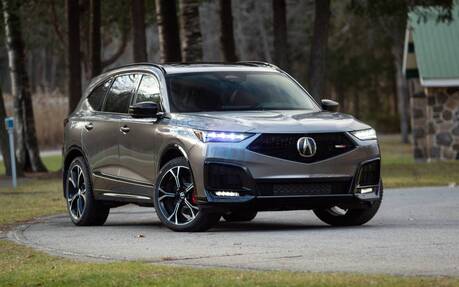
Interior and Cargo
Inside, the GV80 catches the eye with a completely redesigned dashboard featuring a 27-inch OLED digital interface. The instruments and infotainment system are state-of-the-art, the latter also proving very user-friendly thanks to the combination of a touchscreen, shortcut buttons underneath and a rotary controller on the centre console (not to be confused with the redesigned, crystal-like gear selector!). The HVAC controls are touch-sensitive, however, which won't please everyone.
With the exception of the many and very Korean brushed metal inserts, the GV80 impresses with build quality and material selection including textures and colours (several options to choose from). Space is generous in the first two rows, but awfully tight in the available third row. Trunk capacity of 1,034 litres in the five-seat configuration drops to 328 litres in the seven-seat configuration. When all the rear seats are folded down, cargo room increases to 2,379 litres. The GV80 Coupe has only two rows, so some compromises are in order when packing stuff.

Acura has reduced road noise inside the MDX by approximately 10 percent thanks to upgraded fender liners and additional door insulators. The redesigned centre console is more convenient, offering extra storage and a more accessible wireless smartphone charger. The main highlight, obviously, is the 12.3-inch touchscreen featuring Google built-in. While it positively improves the user experience, we have to admit the GV80 has a more pleasant and more ergonomic interface. Also, the transmission buttons don’t make for intuitive manipulation.
The MDX has the edge in the cargo department, with a 513-litre trunk that expands to 2,690 litres when all the rear seats are folded. The third row is a tad more spacious than that of the GV80, but is honestly only suitable for children. Just like Genesis, Acura offers a selection of contrasting interior colours, including the sporty red shown here, but the quality of materials is not quite up to the same standard. The seats in the two SUVs are equally comfortable (with a ton of adjustments in both), while the MDX is the most likely to delight music lovers with its 31-speaker Bang & Olufsen sound system in Type S Ultra trim.
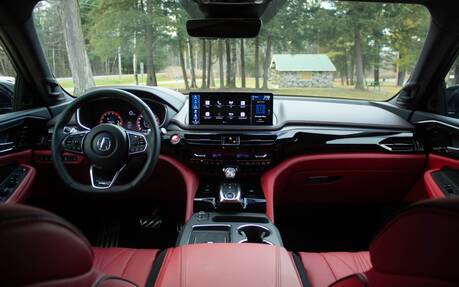
Powertrain
While the GV80 retains its turbocharged four- and six-cylinder engines producing 300 horsepower and 375 horsepower, respectively, the new GV80 Coupe goes a step further, pairing a turbocharged 3.5-litre V6 with a 48V electric supercharger. Output amounts to 409 horsepower, while peak torque is 405 lb-ft. The twin-charged engine also improves throttle response at low and medium revs.
Some drivers won’t like the so-called Active Sound Design system, which aims to replicate the sound of a “large-displacement sports coupe's exhaust,” as Genesis puts it. We didn’t think it was that annoying. On the contrary, we enjoyed the sound. The GV80 Coupe also gets a Sport+ mode and launch control (again, like the German rivals). Few drivers are actually going to use either feature, but they sure are nice to have for maximum excitement behind the wheel. What’s more, brake pedal responsiveness can be adjusted and steering firms up beautifully in Sport+ mode.
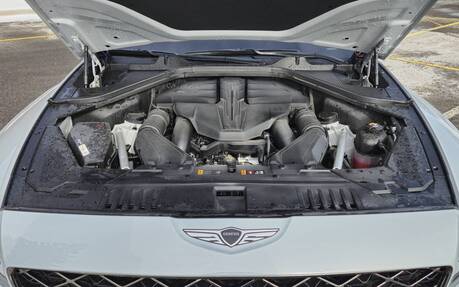
Less powerful and explosive from 0-100 km/h, Acura's SUV continues to rely on a standard 3.5-liter V6 (which runs on premium gasoline even though it's naturally aspirated) producing 290 horsepower, while the Type S Ultra model houses a turbocharged 3.0-litre V6 delivering 355 horsepower and 354 lb-ft of torque. We were nonetheless delighted by the latter's performance, which is expertly served by the 10-speed automatic gearbox. Generally speaking (more so in the sportier drive modes), the engine prefers to operate at higher revs, encouraging you to push it rather than take it easy.
As for fuel economy, neither the GV80 nor the MDX stands out in this regard. Expect to achieve a little over 11 L/100 km with the base engine, and over 12 L/100 km otherwise. In winter conditions where temperatures seldom rose above freezing, we recorded an average of 13.2 L/100 km with the GV80 Coupe and 13 L/100 km with the MDX Type S Ultra in a similar mix of city and highway driving. The addition of a hybrid powertrain would do a world of good, but don't hold your breath. Incidentally, this is one of the reasons why we picked other midsize luxury SUVs as our best buys for 2025. Last but not least: the GV80 can tow up to 6,000 lbs whereas the MDX is limited to 5,000 lbs.
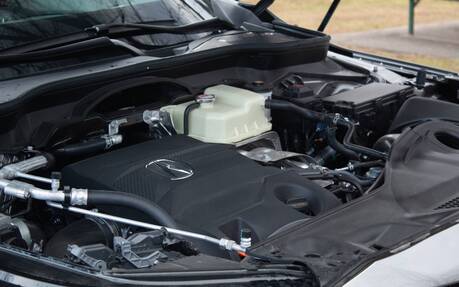
Driving
How do the two SUVs handle on the road? The GV80 prioritizes ride quality and comfort—bless those Ergo-Motion seats that prevent muscle soreness and that smooth air suspension masking road imperfections. Body roll is still noticeable, even in Sport mode (a little less in Sport+ mode). Of course, the available 22-inch wheels aren’t ideal for avoiding potholes.
While the brakes could be a tad easier to modulate, braking power is never an issue. The eight-speed gearbox sometimes seems to hesitate at low speeds. And if you ever want to drive off the beaten path and get your handsome GV80 dirty, there are Sand and Mud drive modes you can select (we didn't get a chance to try them out in the middle of March).
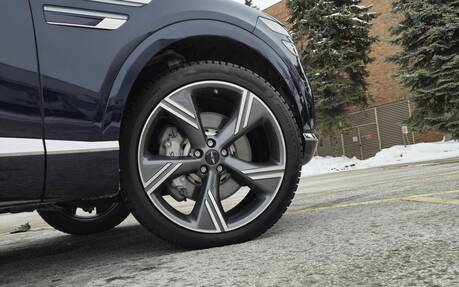
A few undesirable noises were heard here and there, possibly caused by the cold, which wasn't really the case in the MDX. The Japanese SUV felt more solid and particularly more pleasant to drive overall. The driving position is impeccable, and visibility all around is slightly better than the GV80’s (even more so where the GV80 Coupe is concerned).
The adaptive dampers do a fine job of controlling body motions. In Lift mode, they’ll raise the vehicle to better tackle deep snow or a rough trail to the cottage. One last thing: the MDX Type S Ultra similarly employs a system that amplifies engine sounds for a sportier experience behind the wheel. It depends on who you ask, but most drivers probably won't object.
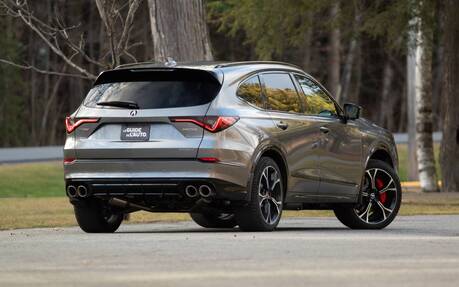
Pricing, Warranty and Service
To sum up, the 2025 Genesis GV80/GV80 Coupe and 2025 Acura MDX are two excellent SUVs that lack only a few elements to aspire to the podium. If you still hesitate between the two in light of what we've just presented, perhaps pricing will make the difference.
The MDX is the least expensive, with a price range from $69,105 to $91,655 including freight, PDI and other fees. The GV80 starts at $75,000 and goes up to $95,500 and even $104,000 for the GV80 Coupe. However, these prices include Genesis at Home (from test drives to valet service), as well as regular maintenance and roadside assistance free of charge for 5 years or 100,000 km. The same applies to limited vehicle and powertrain coverage, while Acura’s basic warranty stops after 4 years or 80,000 km.
Finally, you should know that interest rates at Genesis are much lower at the moment, including a maximum of 4.90 percent financing and 5.90 percent leasing. Acura's rates are 6.99 percent and 7.29 percent, respectively.
